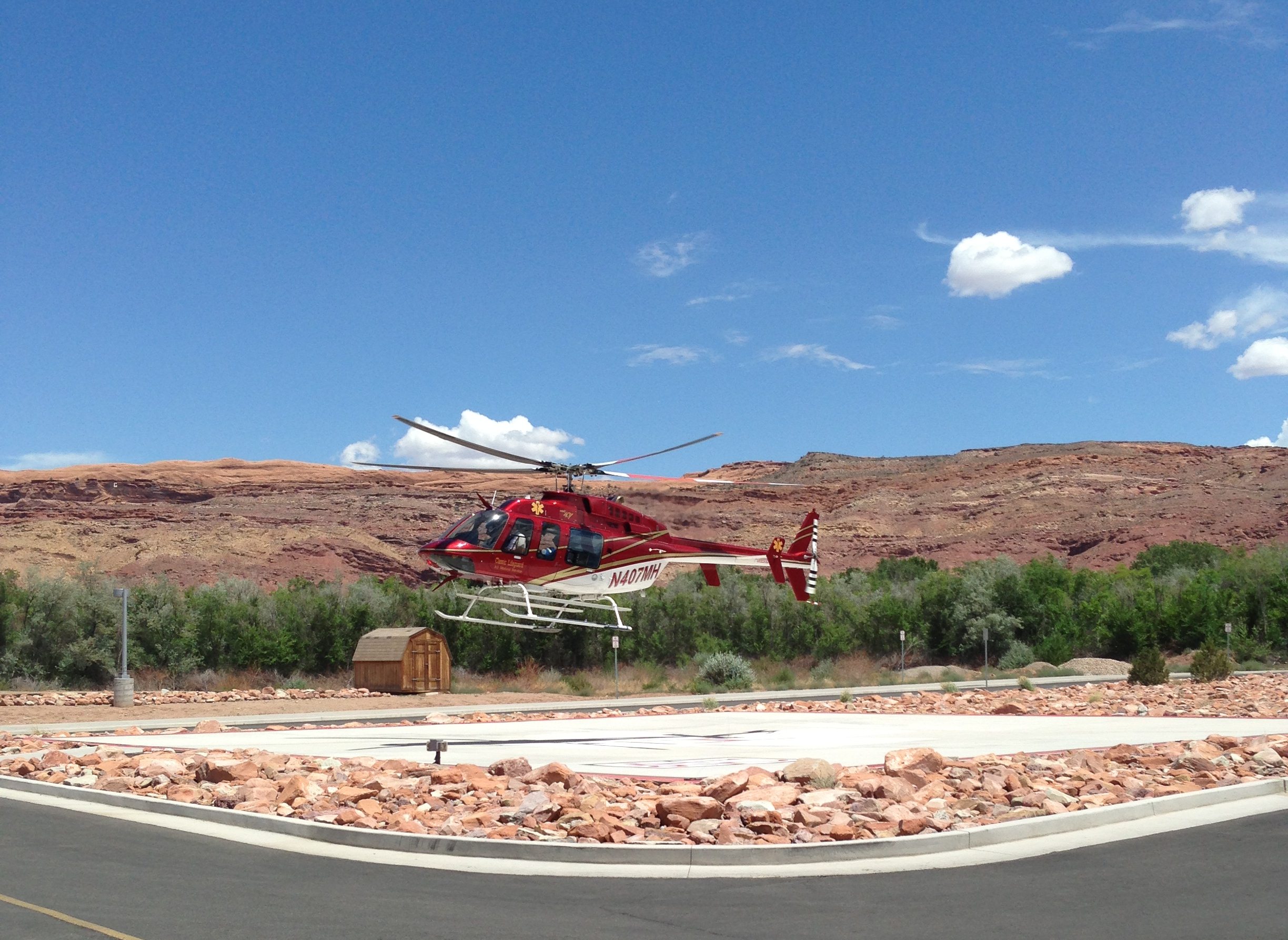Some information may be outdated.
On Monday, July 16, a new emergency helicopter service began operations in Moab. The service, run by Classic Aviation, will likely become the predominant emergency helicopter service used by many of the area’s departments, including the Grand County Sheriff’s Office, Grand County Search and Rescue, and Grand County Emergency Medical Services (EMS).
Historically, local departments have used Grand Junction’s St. Mary’s Hospital and Regional Medical Center’s helicopter service for medical emergencies.
“In my opinion the biggest benefit is that we have more timely air service,” said Andy Smith, the director of Grand County’s EMS. “They (Classic Aviation) are 30 to 45 minutes faster.”
This is because St. Mary’s helicopters are based in Grand Junction, and thus have to fly all the way to Grand County to pick up a patient before returning to Colorado.
Classic Aviation is now using a helipad owned by the Sheriff’s Department south of Moab in Spanish Valley. Eventually they hope to move their operations to Moab Regional Hospital.
“Classic actually approached us. We don’t have any kind of contract signed yet,” said Jennifer Sadoff, the director of marketing and community relations at Moab Regional Hospital.
Classic Aviation, which has its headquarters in Salt Lake City, began looking at opening a base of operations in Moab about six months ago, said Jason Atkins, the company’s vice president.
“The company has been in business for 30 years. In medical transport for over 25 years,” he said. “As we did some research and investigation we found out Moab is a place that could absolutely use an ambulance service.”
Moab will be the company’s fourth base of operations, with others in Riverton, Vernal, and Page, Ariz.
Atkins said that his company’s experience in rural areas of the southwest makes them well suited for Moab.
Classic Aviation has also worked within Grand County many times in the past.
This has usually occurred when the St. Mary’s helicopters are not available. When this is the case, and the closest helicopter is not available, protocol dictates that the next closest helicopter be called in. That helicopter is often Classic Aviation’s.
“They have called us many times this year,” Atkins said. “We take patients to St. Mary’s all the time.”
Classic Aviation did not intend to open their Moab base so soon, planning instead to wait until a deal had been worked out with Moab Regional Hospital, but other agencies in the area were “chomping at the bit,” Atkins said.
The Sheriff’s Office, Search and Rescue and EMS pushed to have the Classic Aviation in Moab as soon as possible, he said.
In many medical emergencies time is critical, Smith said. Smith said that St. Mary’s helicopter provided exceptional service, but they are also have a longer response time.
The proximity of Classic Aviation will allow EMS to continue a program they are working on to help better identify and treat different kinds of heart attacks. The program is designed to identify a ST-Elevation Myocardial Infarction (STEMI), a very serious type of heart attack.
After a STEMI has been confirmed EMS must fly the patient to St. Mary’s in Grand Junction for treatment.
“The national standard right now is we have to have somebody that we have identified has a STEMI, we have to get them to a cath lab within 90 minutes,” Smith said. “We couldn’t always do that with the St. Mary’s helicopter. With Classic here we can get them over there in about 60 minutes.”
Having a helicopter based in Moab will also mean less waiting time for medical emergencies in surrounding communities; Classic Aviation’s helicopter was already called out to Green River in their first week of operation, Atkins said.
However, whether or not Moab Regional Hospital will be moving away from St. Mary’s helicopter service in favor of Classic Aviation’s is still up in the air, said Robb Austin, Moab Regional Hospital’s administrator.
“They have been loyal partners for 30 years and we are very cognizant of that relationship,” he said. “It is important that we maintain that relationship with St. Mary’s.”
Austin said that the hospital has been very happy with St. Mary’s helicopter service and that in many cases the time saved by having a helicopter closer is not critical. This is because it often takes at least 45 minutes to prepare a patient for the flight.
“Usually we know if someone is coming in with a trauma,” Sadoff said. “EMS will call us from the field and say we have a level one trauma. In that situation we would notify St. Mary’s and they would launch their helicopter and it would be here by the time they (EMS) got here.”
The hospital is now in the process of doing due diligence to decide on how to proceed, which “they have said might take a significant amount of time,” Atkins said.
In 2011 Moab Regional Hospital used helicopters to transport patients 83 times. Last year that number was 78.
In 2012 Grand County EMS used helicopters for field transport 32 times, and in 2011 they were used 28 times.
Even with the new helicopter service in Grand County, Smith does not anticipate a change in the number of times emergency medical helicopters are used each year.
“I don’t think we are going to utilize them any more. I think we will probably call them about 30 times each year, as we did in the past. When we use them there is usually no other way of getting patients out,” Smith said. “It’ll just be a lot faster now. The patient care will increase. The patient care will be faster.”
Appreciate the coverage? Help keep local news alive.
Chip in to support the Moab Sun News.





